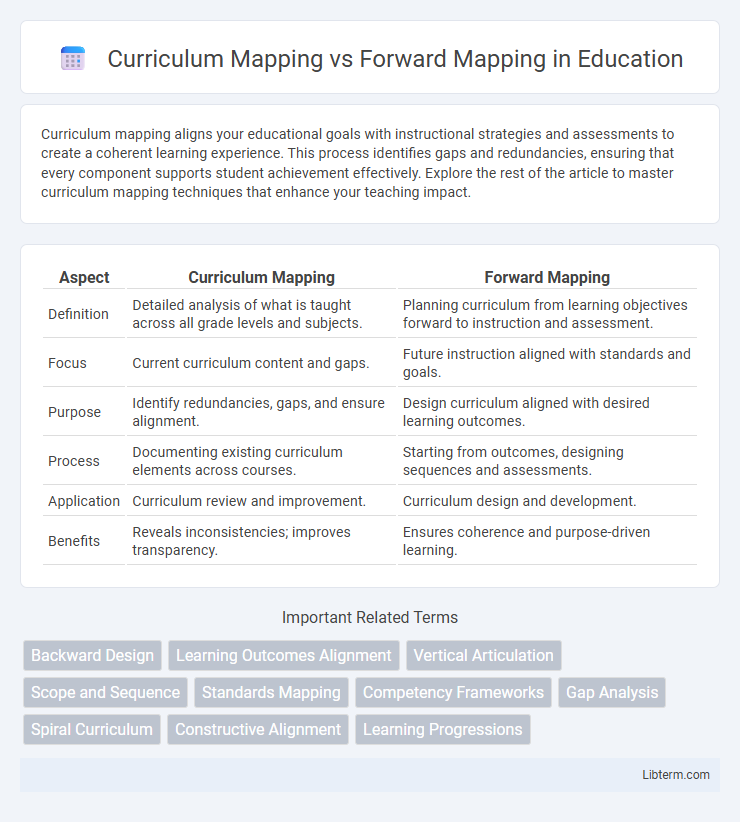Curriculum mapping aligns your educational goals with instructional strategies and assessments to create a coherent learning experience. This process identifies gaps and redundancies, ensuring that every component supports student achievement effectively. Explore the rest of the article to master curriculum mapping techniques that enhance your teaching impact.
Table of Comparison
| Aspect | Curriculum Mapping | Forward Mapping |
|---|---|---|
| Definition | Detailed analysis of what is taught across all grade levels and subjects. | Planning curriculum from learning objectives forward to instruction and assessment. |
| Focus | Current curriculum content and gaps. | Future instruction aligned with standards and goals. |
| Purpose | Identify redundancies, gaps, and ensure alignment. | Design curriculum aligned with desired learning outcomes. |
| Process | Documenting existing curriculum elements across courses. | Starting from outcomes, designing sequences and assessments. |
| Application | Curriculum review and improvement. | Curriculum design and development. |
| Benefits | Reveals inconsistencies; improves transparency. | Ensures coherence and purpose-driven learning. |
Introduction to Curriculum Mapping and Forward Mapping
Curriculum Mapping involves creating a comprehensive visual representation of the curriculum to align learning objectives, assessments, and instructional activities across grade levels and subjects. Forward Mapping, by contrast, starts with clearly defined learning goals and designs curriculum units and lesson plans that sequentially build toward the achievement of those objectives. Both approaches emphasize alignment and coherence, but Curriculum Mapping provides a holistic overview, while Forward Mapping focuses on the step-by-step progression toward targeted competencies.
Defining Curriculum Mapping: Purpose and Process
Curriculum mapping systematically outlines learning objectives, instructional strategies, and assessment methods to ensure alignment across courses and grade levels, enhancing educational coherence. Forward mapping, by contrast, starts with end goals or standards and designs curriculum elements to meet those specific outcomes. The purpose of curriculum mapping is to provide educators with a clear visual representation of what is taught, when, and how, facilitating continuous improvement and gap identification in instructional delivery.
What Is Forward Mapping in Education?
Forward mapping in education refers to the process of designing curriculum by starting with learning objectives and then planning instructional activities and assessments to achieve those goals. This approach ensures alignment between what students need to learn and how educators deliver content, focusing on progression from foundational skills to advanced competencies. Forward mapping promotes a clear, goal-oriented structure that supports student learning outcomes and instructional coherence.
Key Differences Between Curriculum Mapping and Forward Mapping
Curriculum mapping involves a comprehensive review of existing curricula to identify gaps, redundancies, and alignment with learning objectives, focusing on documenting what is currently taught. Forward mapping, in contrast, is a proactive approach that starts with desired outcomes and designs the curriculum to strategically achieve these goals, emphasizing backward design principles. The key differences lie in curriculum mapping's retrospective audit nature versus forward mapping's goal-driven planning process.
Advantages of Curriculum Mapping
Curriculum mapping provides a comprehensive overview of learning objectives, instructional strategies, and assessment methods, ensuring alignment across grade levels and subjects. It enables educators to identify gaps, redundancies, and opportunities for enrichment, promoting a coherent and consistent educational experience. This systematic approach enhances communication among teachers and supports data-driven decision making for curriculum improvement.
Benefits and Applications of Forward Mapping
Forward mapping provides a clear framework for curriculum designers by outlining learning objectives before selecting instructional materials, ensuring alignment with desired educational outcomes. This approach enhances instructional consistency and allows educators to anticipate and address student learning needs effectively. It is particularly beneficial in standardized testing preparation and competency-based education systems, where explicit goal orientation supports measurable progress tracking.
Common Challenges in Implementation
Curriculum mapping and forward mapping both face challenges in aligning educational objectives with instructional practices, often resulting in gaps between intended standards and classroom execution. Ensuring consistent teacher understanding and collaboration is difficult, as miscommunication can lead to incomplete or inaccurate mappings that fail to accurately represent student learning progressions. Data management complexities and resistance to change further hinder effective implementation, reducing the intended impact on curriculum coherence and student outcomes.
Selecting the Right Approach for Your Institution
Choosing between curriculum mapping and forward mapping depends on your institution's goals and existing structures. Curriculum mapping offers a comprehensive overview, aligning courses with learning outcomes and identifying gaps, ideal for institutions seeking holistic curriculum evaluation. Forward mapping emphasizes future skills and competencies, which benefits institutions focused on progressive and competency-based education models.
Case Studies: Curriculum Mapping vs Forward Mapping in Practice
Case studies comparing Curriculum Mapping and Forward Mapping highlight significant differences in curriculum alignment and implementation efficiency. Curriculum Mapping facilitates comprehensive visualization of learning outcomes across courses, enabling educators to identify gaps and redundancies, as demonstrated in studies at institutions like the University of Michigan. Forward Mapping emphasizes a linear progression from standards to assessments, often used in K-12 settings such as in Texas schools, supporting targeted skill development and accountability through measurable milestones.
Conclusion: Choosing the Optimal Mapping Strategy
Curriculum mapping provides a comprehensive overview linking learning objectives with assessments and instructional strategies, ensuring alignment across all educational components. Forward mapping starts with desired outcomes and designs curriculum elements backward, emphasizing clear goal attainment and targeted skill development. Selecting the optimal strategy depends on institutional priorities, whether fostering cohesive curriculum integration with curriculum mapping or focusing on outcome-driven design through forward mapping.
Curriculum Mapping Infographic

 libterm.com
libterm.com